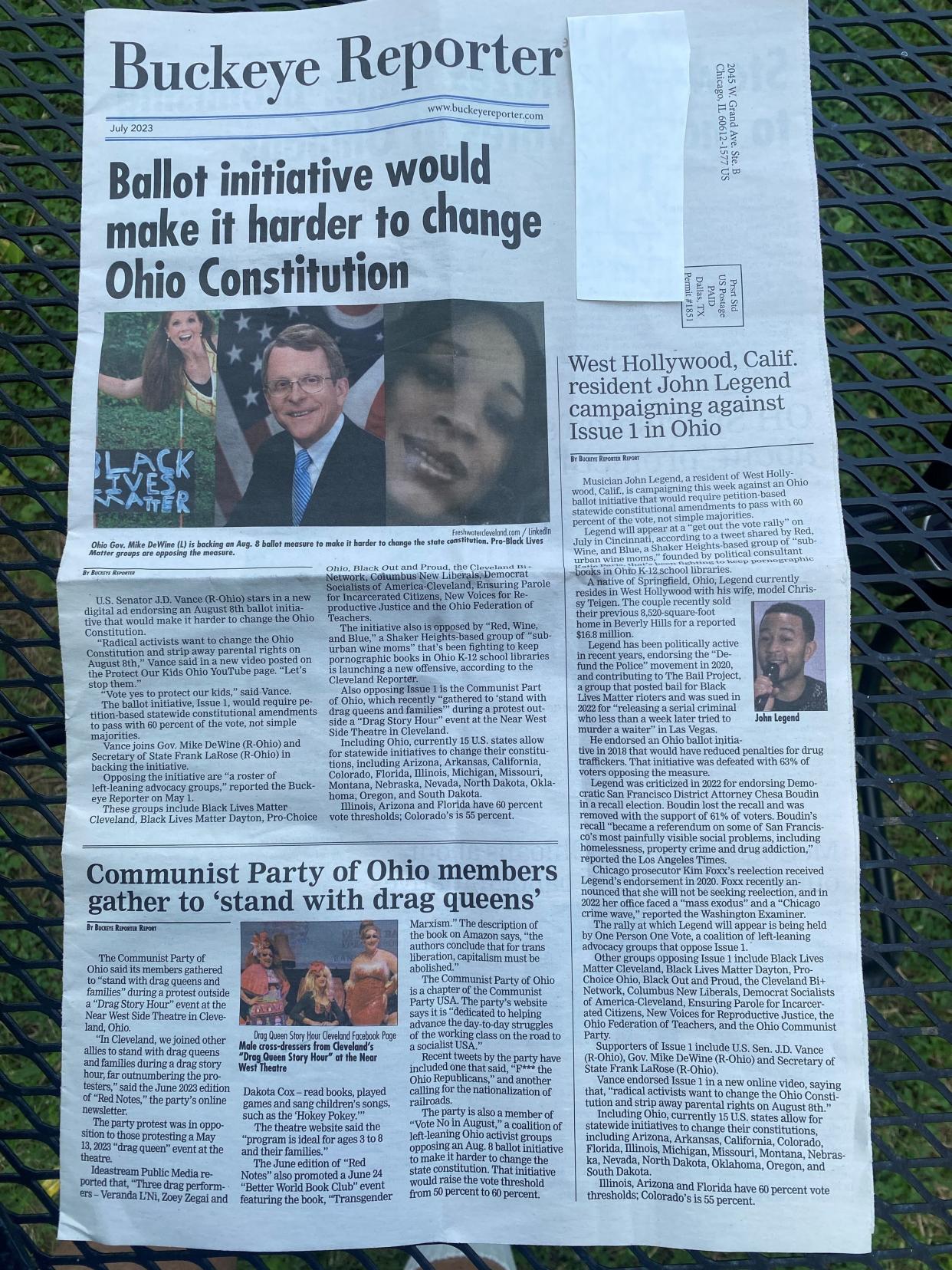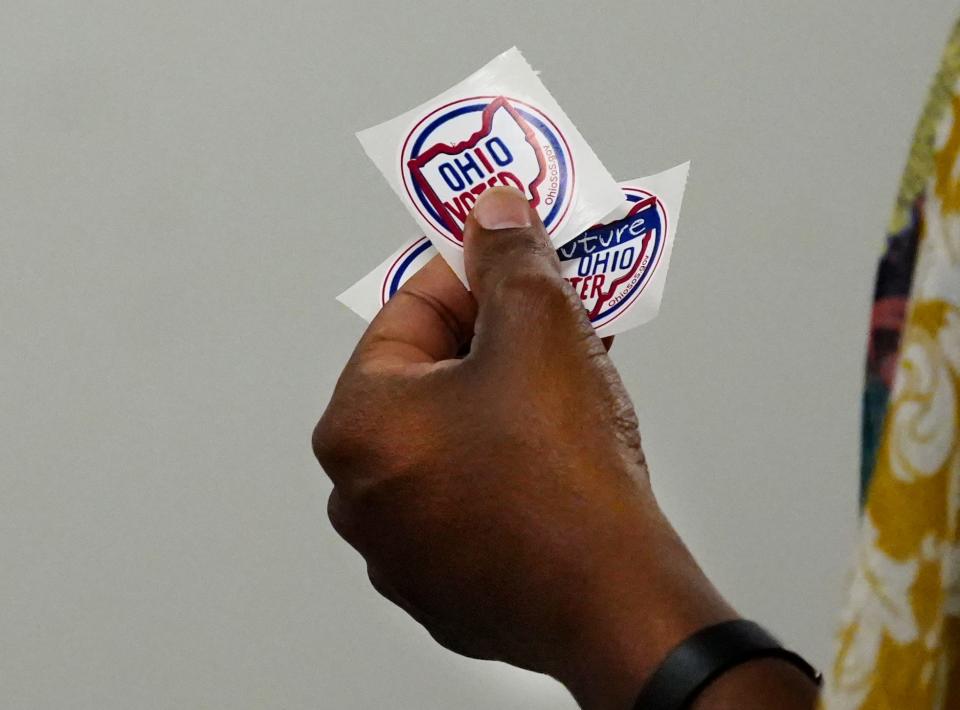Did you get a pro-Issue 1 Buckeye Reporter in the mail? This is the group behind it

Some Ohio voters received an apparent newspaper in the mail called the Buckeye Reporter, featuring articles about Issue 1 and the Aug. 8 election.
But there's more to the flyer than meets the eye.
The publication circulated by Metric Media is an example of what media observers call "pink slime journalism," which disguises low-quality and often biased journalism as local news. Publications such as the Buckeye Reporter have cropped up nationwide in recent years as the media landscape contracts and more people search for content that echoes their personal views.
Ohio Issue 1: Everything you need to know about the August special election
The July issue of the Buckeye Reporter arrived in mailboxes as Ohioans prepare to vote in the Aug. 8 special election on Issue 1. If passed, Issue 1 would require 60% of the vote to enact constitutional amendments − instead of a simple majority − and change the signature-gathering process for citizen amendments.
A reader provided the USA TODAY Network Ohio Bureau with photos of the Buckeye Reporter after getting it in the mail. Here's what voters need to know about it.
Who's behind Buckeye Reporter?
The Buckeye Reporter is owned by Metric Media, according to the publication's website. The company boasts 1,300 "community news sites" across the country, including over 25 publications that produce Ohio content. The Metric Media Foundation operates out of Missouri and recently re-registered as the Community News Foundation, according to state business filings.
Reports from the New York Times and Columbia Journalism Review indicate Metric Media is part of a complex network of companies focused on "local news." One of the people behind this network is Brian Timpone, a conservative businessman, former TV journalist and former Illinois House Republican aide. Timpone founded the company Journatic, which faced blowback for offshoring writer jobs to make cheap, hyperlocal content that used fake bylines.
Timpone also spearheaded Local Government Information Services, which primarily runs publications in Illinois that are similar to the Buckeye Reporter.
"I think the cynical thing about it is that there’s often no, or very minimal, disclosure of who’s publishing these, so the public often doesn’t have a pathway to know where this information is coming from or who’s paying for it," said Tim Franklin, who leads the Medill Local News Initiative at Northwestern University.
Representatives for Metric Media did not respond to an email seeking comment. Buckeye Reporter's about page says the company was created "to fill the void in community news after years of decline in local reporting by legacy media."

Who's funding the network?
The Columbia Journalism Review pinpointed multiple donors to the Metric Media Foundation, including an organization run by Illinois conservative activist John Tillman. Other contributors were DonorsTrust and the National Christian Charitable Foundation.
Illinois LGIS websites note that they're funded in part "by advocacy groups who share our beliefs in limited government," but the Buckeye Reporter does not have such a disclaimer.
What do they publish?
The Buckeye Reporter included several articles that highlight support for Issue 1 and criticized the measure's opponents. One headline on the front page read, "West Hollywood, Calif. resident John Legend campaigning against Issue 1 in Ohio." Legend is an Ohio native from Springfield.
A recent online story featured comments from Vote Catholic Ohio that called Issue 1 necessary to "protect the preborn," while another highlights opposition by "radical leftists" such as the Communist Party of Ohio.
“This is being skewed in such a magnificent way," said Nicole Kraft, a communications professor at Ohio State University.
The website also features articles that are favorable to Ohio Republicans.
A spokesman for the pro-Issue 1 Protect Our Constitution declined to comment on whether the group is working with Metric Media. The organization is paying for ads to promote Buckeye Reporter stories on Facebook, according to Meta's Ad Library.
What does this mean for Ohio voters?
This isn't the first time these publications have dabbled in Ohio politics. Cleveland.com reported that Metric Media published articles in favor of former U.S. Rep. Jim Renacci during the 2022 gubernatorial primary against Gov. Mike DeWine.
Experts say both conservative and progressive groups − and even companies − are behind these organizations. And it's unclear how effective they are. A recent Stanford University study, which is in its pre-print phase, found only 3.7% Americans were exposed to "pink slime" websites around the 2020 election, although that does not account for hard copies sent in the mail.
Franklin said these publications capitalize on trust in local news, with the goal of creating content that goes viral − even if it's not fully accurate. Still, he believes voters are smart enough to sniff out a partisan agenda.
But Kraft cautioned that these outlets could proliferate even more as the journalism industry contends with challenges.
"This has existed since the beginning of journalistic time," Kraft said, "but its reach has never been greater."
Haley BeMiller is a reporter for the USA TODAY Network Ohio Bureau, which serves the Columbus Dispatch, Cincinnati Enquirer, Akron Beacon Journal and 18 other affiliated news organizations across Ohio.
Get more political analysis by listening to the Ohio Politics Explained podcast
This article originally appeared on The Columbus Dispatch: Ohio Issue 1: Voters receive Metric Media newspaper ahead of election

